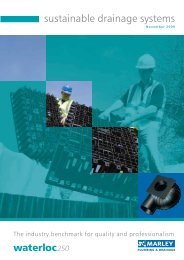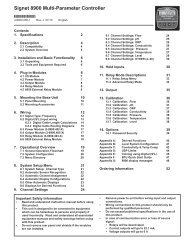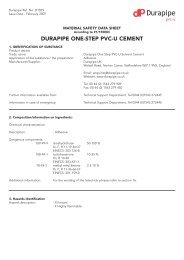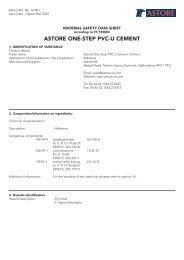VKDUALBLOCK
Underground Drainage Brochure - Forward Builders' Supplies
Underground Drainage Brochure - Forward Builders' Supplies
- No tags were found...
Create successful ePaper yourself
Turn your PDF publications into a flip-book with our unique Google optimized e-Paper software.
Installation data:<br />
Pipe laying<br />
Concrete<br />
slab<br />
polythene<br />
membrane<br />
Less than<br />
600mm<br />
backfill<br />
Pipe<br />
diameter<br />
50mm or 100mm<br />
dependent on<br />
in situ soil type<br />
and condition<br />
Paving slab<br />
75mm min<br />
granular material<br />
Bed and surround with<br />
suitable granular material<br />
100mm<br />
100mm min<br />
Pipe diameter<br />
100mm<br />
Trench dug out of<br />
compacted hardcore<br />
Bed and surround with<br />
suitable granular material<br />
Shallow domestic drains<br />
Pipes laid at depths less than 600mm and which are not<br />
under a road should, where necessary, be protected against<br />
damage by placing over them a layer of concrete, paving slabs<br />
or similar. A minimum 75mm cushioning layer of granular<br />
material must be laid between pipes and the slabs or concrete.<br />
Where drains are laid in fields, additional protection may<br />
be required from heavy vehicles and equipment. It is<br />
recommended that the installation is carried out with<br />
a concrete slab spanning the trench as shown for drains<br />
under private roads (right).<br />
Drains under solid ground floors<br />
Drains often have to be laid under buildings in order to connect<br />
sanitary pipework which has been positioned some distance<br />
from the outer walls. Where this occurs, deep hardcore within<br />
the foundation boundaries should be compacted first. The<br />
trench for the pipe should then be excavated and suitable<br />
material employed for the bedding and backfilling operation.<br />
If trenches are dug from original ground, pipes may be laid<br />
and surrounded as necessary before the top layer of hardcore<br />
is formed. Where a pipe passes through a wall or foundation<br />
of a building, a lintel or sleeve should be built-in to provide<br />
clearance around the pipe.<br />
Concrete bed & surround<br />
<br />
accommodate ground movement and other differential<br />
settlement that may occur under normal conditions.<br />
Therefore, the use of concrete bed and surround is not<br />
recommended and only under special circumstances, at very<br />
shallow cover depths or where it is necessary to safeguard<br />
foundations, should it be used. Where the use of concrete<br />
bed and surround is unavoidable, it is recommended that<br />
pipes are laid in 3 metre lengths and a compressible board<br />
is shaped to fit around each joint. Pipes should also be<br />
wrapped with polythene to prevent the ingress of cement<br />
slurry into ring seal joints.<br />
For applications in accordance with DTP requirements, please refer to the technical design and installation guide, available<br />
to download from marley.co.uk<br />
14
















